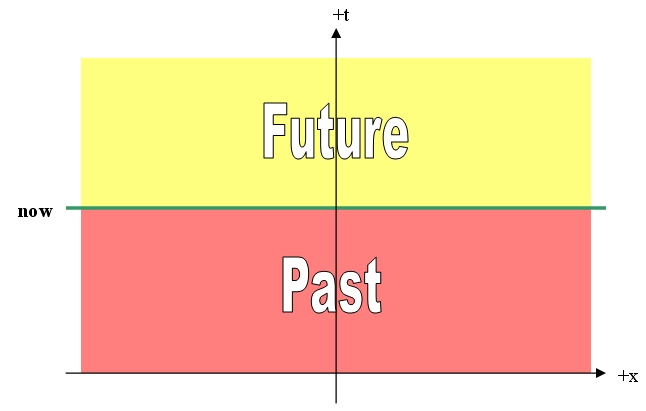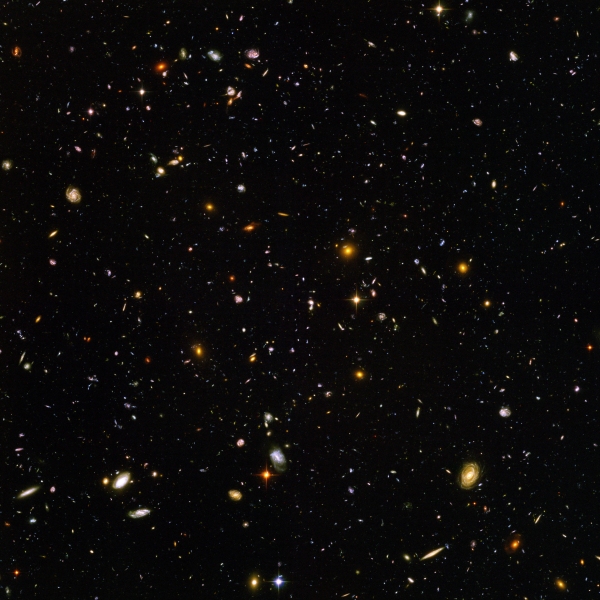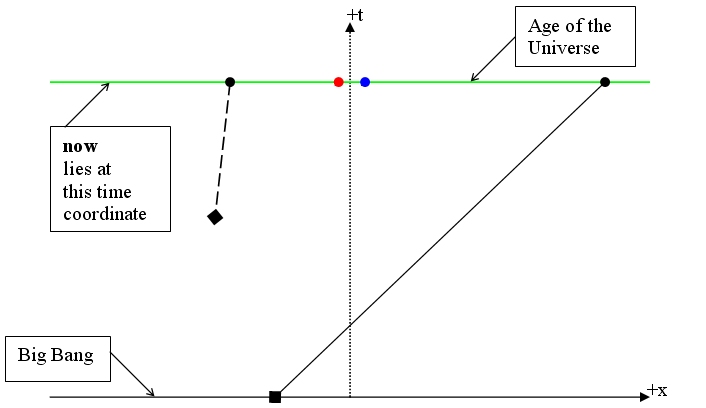|
There is some thought that at a small enough scale, space
and time might not be continuous. For our purposes we can stay well away from
the realm in which that may be true so I will treat them as continuous here.
No matter when I say now is I will be wrong. All I can do is
capture it between past and future times that I may place as close together as
I like. I am fairly confident in saying that by my clock now sits
between midnight yesterday and midnight tonight.
How tight may we place the limits that encompass now?
A twenty-four hour span seems overly generous. I can, at this moment, write
that now is between 8:06 AM and 8:07 AM on 1/30/2009. Perhaps with
improved typing speed I could reduce that span from a minute to a half minute
or so but should I be limited in constraining now to how fast I can
type, or even how fast I can think? Probably not.
For the purposes of this discussion we could take the bit of
time containing now to be a nanosecond. That is one thousandth of a
millionth of a second. It is a short time span on a human scale but light in a
vacuum covers about 30 centimeters in that time so it is actually 30 cm of
time. There are scientific instruments that can easily measure bits of time
this fine. With this we might say that the time of now is an instant contained in the nanosecond indicated on my
very precise clock.
“But wait!”, as they say on those TV pitches. Things are
not that simple. Consider two very precise and perfectly functional clocks,
one in a GPS receiver in my office and the other on a GPS satellite orbiting
Earth at an altitude of 20,000,000 meters.
The two clocks are in motion relative to one another so
special relativity applies. One is in free-fall around Earth while the other
is prevented from falling freely by the impenetrability of matter so general
relativity applies. The combination of the motion of the orbiting clock and
the gravitational field affecting the office clock distorts time and space so
that in the office reference frame the orbiting clock runs faster than the
office clock. This is not a mechanical issue with the clocks. The orbiting
clock as observed from Earth actually ages faster than
the office clock by 38,000 nanoseconds per day. In fact this difference must
be taken into account to make the GPS work on Earth.
After 10 years in orbit the satellite clock would be ahead of the office clock by 0.1387 seconds. Attributing awareness to the clocks, each becomes an observer and “knows” that the now instant is in its current nanosecond, therefore the other clock must be in error by 13,870,000 nanoseconds. But wait yet again. It gets worse. Not only will the clocks disagree on what time it is but they will not agree on the order in which distant events occur.

Let us suppose that the clocks were synchronized prior to
the launch of the satellite clock into orbit and consider that instant of
synchronization the “birth” of the twin clocks. The twins are separated
and have different life experiences. One sits quietly on a desk under the
influence of gravity. The other is rocketed into space and free-falls
around the Earth at a speed of about 3900 meters per second in effectively zero
gravity. All the while both clocks are ticking away faithfully counting
nanoseconds that add up to their age and experiencing now in their
current nanosecond.
Let’s construct a spacetime diagram of the two clock situation from the point of view of the office clock at an instant during an orbit of the satellite clock. The dots lying on the
lines of simultaneity
represent the clocks. A trail of “object found here” events for each object is called the object’s
world line.
The axes are scaled with office time and distance. The satellite clock times and distances are transformed for display on the office reference frame in accordance with the relativity principles.
Figure 2
 Lines of Simultaneity on Spacetime Diagram
Lines of Simultaneity on Spacetime Diagram
A line of simultaneity on a spacetime diagram is the locus in spacetime of all the events that are seen as simultaneous with now by a particular observer. For observers at rest in the reference frame it is a horizontal line, reflecting that all those events have the same time coordinate.
As seen in Figure 2, for an observer in motion in the reference frame, the undeniable mathematics of relativity shows that the line of simultaneity is at an angle to the horizontal. The effect is greatly exaggerated for clarity in this diagram but it is real.
Notice in figure 2 that events that are simultaneous for the
office clock may be past or future events for the satellite clock, depending on
the spatial separation of the events from the clocks. Event A is in the office clock’s past and the satellite clock’s future. Event B is in the satellite clock’s past and the office clock’s future. No amount of redrawing this diagram for different reference frames can get the two lines of
simultaneity to coincide as long as the relative speed of the clocks is not zero.
Also notice that the office clock sees the satellite clock
in its now. The satellite clock sees the office clock in its future.
Or I might say the satellite clock shares now with a past state of the office clock. In any event with a now line and line of simultaneity yielding different versions of the past/future divide, we have a problem. I am indebted to Professor George F. R. Ellis for helping me out of this difficulty. His paper “Physics in the Real Universe: Time
and Spacetime” contains details. I will try to make the solution appear reasonable without replicating the Ellis paper here.

Let’s go back a bit and think about where now fits on a spacetime diagram. Prior to 1905 it was clear to everyone who thought about it at all that now was a boundary between past and future that extended throughout space. As such it could be represented on our spacetime diagram by a solid horizontal line of infinite extent. Remember we suppressed two of the spatial dimensions to simplify the diagram so the spacetime diagram line would be a surface with the addition of the y-dimension and a volume with the addition of the z-dimension. Figure 3 below represents the pre-relativity notion of now.
Figure 3
 Pre-Einstein Concept of Now
Pre-Einstein Concept of Now
Figure 3 shows a nice simple now extending through all space at a single instant in time. With the unification of space and time into spacetime that followed from the relativity principle, the picture gets more complicated. That is the source of our problem.
Figure 4
 Future/Past Boundary in Relativistic View
Future/Past Boundary in Relativistic View
In Figure 4 I have illuminated a square of spacetime centered on an object represented by the small light green circle. The world line of that object is represented by the darker green post beneath the object. The two blue lines forming the upward opening V are the only possible world lines of light
photons
emitted from our object. Photons cover one meter of distance in one meter of time so their world lines are 45 degrees from the vertical. The two blue lines forming the downward opening V are the only possible world lines of photons absorbed by our object.
The two Vs, extended to infinity, are called light-cones since they are bounded by photon world lines. They divide spacetime into three regions labeled future, past and not future or past. Due to the fact that no object, or even actionable information, can travel faster than the speed of light, the only events that can change the state of an object at its current spacetime location must lie in or on its past light-cone. The only events that may be influenced by events in which an object participates must lie in or on its future light-cone. Events that lie in the not future or past region can have no
causal relationship
with events involving an object. Those regions of spacetime are not part of the objects past or future.
The implication of this is that now for any object only applies to a very small neighborhood at the objects location. The concept of my now extending to distant objects is inconsistent with relativity principles.
Remember we set out to find the spacetime location of now. I think we have enough ideas in hand at this point to define the spatial extent of now. Every object in the universe exists in an instant on its world line called now. Only at that moving spacetime location does the object exist. The boundary between past and future, rather than being an extended space-like surface, seems to be a collection of spatial points, the points being scattered throughout the universe, one for every particle, perhaps distributed a bit like this.
 Snapshot of Some Now Locations at Age of Universe in About 2004
Snapshot of Some Now Locations at Age of Universe in About 2004

How about the time coordinates of the now points? It
is tempting to set the time of now to the
proper time
along each world line. Certainly that would match the perception of
both our test clocks. Let’s retrieve the satellite clock from orbit and set it
alongside the office clock, noting that their readings differ by over a tenth
of a second. But both clocks have been faithfully recording each nanosecond of
the clock’s lifetime and now has always been in the current nanosecond.
Each clock knows with absolute certainty that as they sit on the shelf, snug
together, they share the same now and with equal certainty that they do
not. Using the age of objects for now’s time coordinate leads to a
paradox.
We could resolve this paradox if the time coordinate of now were divorced from the age of any particular object. Before we try to do that we should take a closer look at the nature of objects. By three minutes after the
Big Bang
the basic constituents of ordinary matter, some relatively heavy particles called
baryons
and some relatively light particles called
leptons,
had settled out at their final number. In the entire universe there are about 1080 of each. The protons and neutrons that make up atomic nuclei are baryons. The electrons that fill the atom’s shells following the laws of quantum mechanics are leptons. The total mass of all the atoms in existence is carried by these primordial articles.
Now consider a massive object, a rock for instance. The baryons and leptons from which it is made have been around since near the beginning of time and will be around forever barring some cataclysmic end of the universe. Those baryons and leptons have been organized into the atoms of the rock in the process of stars being assembled by gravity and destroyed in explosions called supernovae. Rocks are literally made of stardust.
There is nothing special about the baryons and leptons from which the rock is built. It is their arrangement into atoms and the incorporation of those atoms into the structure of the rock that gives the rock its character. Mass in the form of baryons and leptons is permanent. The specific arrangement of the baryons and leptons is temporary.
Eventually the rock will be ground to dust by its environment, and dispersed into space when the Sun explodes. A bit later the dust will be gathered up by gravity into a star where the constituent protons, neutrons and electrons may be separated and incorporated into new atoms. The star will explode at the end of its life cycle and under the influence of gravity some of the original rock matter may be used in constructing a new planet, to eventually become part of a parakeet, for example. All living creatures are also built from stardust.
In fact there is probably no atom in the universe whose constituents are the same age, what with the different relativistic histories of the primordial particles that combined to form the atom. Still it seems reasonable that the constituents of the atom must share the same instant of existence (now), since their coexistence is required to make the atom a viable entity. If one of the constituents has been left in the atom’s past or has not yet arrived from the atom’s future, we can’t very well assemble the atom. With each particle of matter having its own version of now, what are the conditions under which particles can coexist.
It seems that the now time coordinate for all the components of an atom must be the same in order for the atom to exist. But can we stop there? I think the now time coordinate for all the atoms in an object must be the same. And by the same reasoning the now time coordinate for all the objects in a system must be the same. This takes us to the point where the now time coordinate must be the same for all the particles in space at least spanning the Milky Way galaxy. So the requirements we see emerging for the time of now are: it cannot be the proper time of any particular object and it must be the same for huge numbers of particles.

There is one particular time, not associated
with any isolated object or subject to relativistic variation, which might be a
candidate for the time of now. It does appear from a large body of
evidence that the universe we inhabit had a definite beginning in an event that
happened very suddenly, perhaps in no time at all, and everywhere at once. As
far as we can tell, time started in that instant and the universe began to
expand from a dense hot state. We call this event the Big
Bang and it marks a sort of absolute zero of time.
It would be nice if Nature left us a clock that could tell
us how long it has been since the Big Bang, since all of out time keepers are
out of whack, being subject to relativistic variation. Actually She did. It
is called the cosmic microwave background radiation (CMB) and is the remnant of
the flash from the Big Bang itself. It shows that the Big Bang occurred 13.7
±2 thousand million years ago.
The CMB is remarkably uniform coming in from all directions,
once corrected for the motion of earthbound observation relative to the comoving reference frame. The age of the
universe as recorded in this radiation seems to be everywhere the same. If we
like we could draw a spacetime diagram based on the commoving reference frame
where the t-axis starts at the Big Bang. In a sense this would be a universal
spacetime diagram. The diagram below represents a snapshot at a particular age
of the universe.
Figure 5
 Universal Spacetime Diagram
Universal Spacetime Diagram
I propose to let the now experienced by every object
lie on the universal age line regardless of the object’s age. It was born at a
certain age of the universe in the now, it lives through some temporal
extent of the universe in the now and it will die at a certain age of
the universe in the now. Accelerations or exposure to gravity causes
objects to depart from the spacetime path of maximal
aging that free floating objects follow, and age more slowly than objects
on that path. Aging most rapidly is the universe itself.
In Figure 5 we see the world lines of four objects. The black
object with the shorter world line emerged well after the Big Bang and lived
through some relativistic adventures that stretched its time units as seen in
this spacetime diagram. One could count the number of time unit dashes to
arrive at the age of this object. The object born at the Big Bang would be a
CMB photon. Since it travels at light speed it
would not have aged at all between the Big Bang and now. There are no
dashes to count on its world line. The red and blue objects are our two clocks
with world lines so short on this scale as to be not seen.
So where is now in spacetime? For any object, in
space it can only be here. Its time coordinate is indefinite but conveniently
chosen at the age of the universe. Now is not a continuous surface in
spacetime but a collection of points with the spatial coordinates of the
objects under consideration. On spacetime diagrams we may use a horizontal
line at the age of the universe to indicate the temporal location of now,
bringing the up-time end of all world lines to a common time coordinate and
letting the proper time float.
The future is filled with possible events. The past is
filled with realized events. What a particular clock reads at now is
determined by the clock’s history. The key issue is that all objects lie on
their world line boundary between past and future, whatever their own clock may
read.

| 



